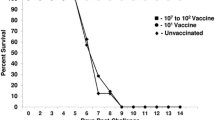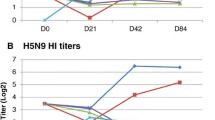Summary
An evaluation was undertaken of the efficacy of vaccination of day-old chicks with the Blacksburg (B1) strain of Newcastle disease virus (NDV) followed at various times by vaccination with the Komarov (K) strain. Antibody was detected by the haemagglutination inhibition (HAI) test one week after vaccination with B1 and titres peaked at three weeks and had declined to undetectable levels by nine weeks.
After subsequent vaccination with K strain at five, seven or eight weeks of age levels of HAI antibody (titre 80 to 640) were detected after three weeks. Birds vaccinated at seven weeks were tested for antibody and resistance to challenge beyond 19 weeks of age. In this group the HAI titres remained constant (80 to 640) up to 32 weeks of age and then steadily declined to 10 to 20 at 44 weeks of age.
A linear relationship between HAI titre and virus neutralising index (VNI) was demonstrated with a range of selected sera. Only birds with an HAI titre of 80 or greater resisted artificial challenge. It is recommended that, following B1 vaccincation at day-old and K vaccination at seven weeks old, revaccination with K strain should be performed at intervals of not more than seven months.
Résumé
Une evaluation de l'efficacité de la vaccination de poussins d'un jour à l'aide des souches Blackburg (B1) du virus de la maladie de Newcastle, suivie à différents moments par la vaccination à l'aide de la souche Komarov (K), a été entreprise. Les anticorps furent détéctés par inhibition de l'hemagglutination (HAI), une semaine après la vaccination avec la souche B1 et le titre atteignit un pic à 3 semaines pour décliner jusqu'à des niveaux indétectables à neuf semaines. A la suite de vaccinations consécutives avec la souche K à cinq, sept ou huit semaines, les niveaux d'anticorps HAI furent détectés après trois semaines. Les oiseaux vaccinés à sept semaines furent examinés pour les anticorps et la résistance à une épreuve au delà de 19 semaines d'âge. Dans ce groupe les titres HAI sont restés constants (80 à 640) jusqu'à l'àge 32 semaines, puis ont diminué régulièrement jusqu'à 10 à 20 à l'âge de 44 semaines.
Une relation linéaire entre le titre HAI et l'index de neutralisation du virus (VNI) a été démontrée sur une gamme de sérums choisis. Seuls les oiseaux ayant un titre HAI de 80 ou plus ont résisté à l'épreuve artificielle. On recommande que, après une vaccination B1 à un jour, et une vaccination K à l'âge de sept semaines, une revaccination K soit réalisée à des intervalles n'excédant pas sept mois.
Resumen
Se llevó a cabo una evaluación de la eficacia de la vacunación de pollitos de un día, con la cepa Blacksburg (B1) del virus de la enfermedad de Newcastle, seguida de varias aplicaciones vacunales periódicas con la cepa Komarov (K). Se detectaron anticuerpos mediante la prueba de inhibición de la hemaglutinación, una semana después de la vacunación con B1, los títulos alcanzando el pico a las tres semanas y declinaron a niveles no detectables a las nueve semanas.
Después de aplicaciones vacunales periódicas con la cepa K, a las cinco, siete u ocho semanas de edad, se detectaron anticuerpos mediante la prueba de inhibición de la hemaglutinación (títulos 80 a 640), después de tres semanas. Las aves vacunadas a las siete semanas, recibieron una descarga y se les hizo prueba de anticuerpos, después de las 19 semanas de edad. En este grupo los títulos de anticuerpos permanecieron constantes (80 to 640) hasta las 32 semanas de edad y después declinaron lentamente a 10 ó 20 a las 44 semanas de edad.
Se demostró una relación lineal entre los títulos hallados y el índice viral neutralizante, en un rango de sueros seleccionados. Solamente las aves con títulos de 80 o más altos resistieron la descarga artificial. Se recomienda que, seguidamente a la vacunación con B1 a un día de edad y con K a las siete semanas, las revacunaciones con la cepa K debería hacerse con intervalos de no más de siete meses.
Similar content being viewed by others
References
Ahmed, A. A. S., Roda, I. M., Abbasi, K. H. &El-Sisi, M. A. (1967).Journal of Veterinary Science,4, 115–133.
Allan, W. H., Lancaster, J. E. &Toth, B. (1978). Newcastle disease vaccines: Their production and use. Food and Agriculture Organization of the United Nations, Rome, pp 15–17, 80–108.
Amin, M. M. (1985).Asian Livestock,10, 8–11.
Anon (1971). Methods for examining poultry biologics and for identifying and quantifying avian pathogens, National Academy of Sciences, Washington DC, pp 82.
Beard, C. W. (1980). In:Isolation and Identification of Avian Pathogens, 2nd edn: (Eds S. B. Hitchneret al.), American Association of Avian Pathologists, Creative Printing Company, Inc, Endwell, New York 13760, pp 129–135.
Beard, C. W. &Easterday, B. C. (1967).Journal of Infectious Diseases,117, 55–70.
Beard, C. W. &Hanson, R. P. (1984). In:Diseases of Poultry, 8th edn. (Eds M. S. Hofstad,et al.), Iowa State University Press, Ames, Iowa, pp 452–470.
Chowdhury, M. S. I., Chowdhury, T. I. M. F. R., Sarker, A. J. &Amin, M. M. (1981).Bangladesh Veterinary Journal,15, 19–27.
Chowdhury, T. I. M. F. R., Sarker, A. Z., Amin, M. M. &Hossain, W. I. M. A. (1982). A Research Report: Studies on Newcastle disease in Bangladesh, pp 12–20.
Crowther, R. W. (1964).Journal of Comparative Pathology,74, 151–162.
Hamann, I. (1958).Monatshefte für Veterinarmedizin,13, 99–102.
Hanson, R. P. (1964).Newcastle disease virus: an evolving pathogen, University of Wisconsin Press, Madison, USA, pp 1–352.
Hanson, R. P. (1980). In:Isolation and Identification of Avian Pathogens, 2nd edn. (Eds S. B. Hitchneret al.), American Association of Avian Pathologists, Creative Printing Company, Inc., Endwell, New York 13760, pp 63–66.
Haplin, B. (1978).Patterns of Animal Disease, English Language Book Society and Bailliere Tindall, London, pp 151–157.
Herbert, W. J. (1970).Veterinary Immunology, Blackwell Scientific Publications, London, pp 13–24.
Holmes, H. C. (1979).Journal of Comparative Pathology,89, 11–19.
Kuhavanta, S. (1978).Asian Livestock,3, 4–7.
Kumar, K., Narayana Rao, C. V., Pankajam, B. &Kannan Babu, N. (1981).Indian Veterinary Journal,58, 593–598.
Lam, K. M. &Hao, Q. (1987).Veterinary Microbiology,15, 41–48.
Lancaster, J. E. (1964).Veterinary Bulletin,34, 57–76.
Lancaster, J. E. (1966). Newcastle Disease: a review of the literature published between 1926 and 1964, Canada Department of Agriculture, Ottawa, Monograph No. 3.
Levine, P. P. &Fabricant, J. (1952).Cornell Veterinarian,42, 449–457.
Raggi, L. G. &Lee, G. G. (1962).Avian Diseases,6, 297–301.
Read, L. J. &Muench, H. (1938).American Journal of Hygiene,27, 493–497.
Satyanarayana, A., Madhava Krishna Reddy, A., Madhusudhana Swamy, D. &Akbar, S. A. (1977).Indian Veterinary Journal,54, 509–516.
Spradbrow, P. B., Samuel, J. L. &Latif Ibrahim, A. (1988).Veterinary Microbiology,16, 255–262.
Stone, H. D., Boney, Jr. W. A. &Coria, M. F. (1975).Avian Diseases,19, 651–656.
Toth, B. &Markovits, P. (1964).Acta Veterinaria Hungarica,14, 339–345.
Author information
Authors and Affiliations
Rights and permissions
About this article
Cite this article
Saifuddin, M., Chowdhury, T.I.M.F.R., Sarker, A.J. et al. Protection conferred by vaccination with Blacksburg and Komarov strains of Newcastle disease virus against Newcastle disease in Bangladesh. Trop Anim Health Prod 22, 263–272 (1990). https://doi.org/10.1007/BF02240411
Accepted:
Issue Date:
DOI: https://doi.org/10.1007/BF02240411




